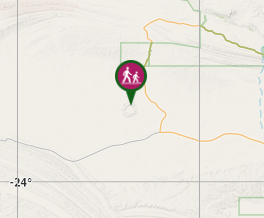Aussie Bushwalking can keep track of your bushwalks.
Login/signup to tick this walk off.Menu
According to Aboriginal belief, Tnorala was formed in the creation time, when a group of women danced across the sky as the Milky Way. During this dance, a mother put her baby aside, resting in it’s wooden baby-carrier (tarne - pronounced tar-na). The carrier toppled over the edge of the dancing area and crashed to earth where it was transformed into the circular rock walls of Tnorala. The Aboriginal and scientific interpretation of the Bluff are similar in that both have a celestial origin. Scientists believe that around 142.5 million years ago anobject from space, believed to be a comet about 600 metres wide, crashed to earth, blasting a crater some 20 km across. Today’s landsurface is about 2 km lower than the original impact surface and the
bluff is about 5 km in diameter, reduced over time by erosion. The remnant crater was named Gosses Range by the explorer Ernest Giles in 1872 after H. Gosse, a fellow of the Royal Society.
Getting there
The Reserve is about 175 km west of Alice Springs. Access is via Larapinta Drive or via Namatjira Drive. A 4WD is recommended for the last 5 km drive to the Reserve. A Mereenie Tour Pass is only required if visitors continue along the Red Centre Way to Watarrka National Park. All roads can be impassible after heavy rain.
When to visit
The Reserve is accessible all year round. The cooler months (April to September) are the most pleasant.
A picnic area is situated a short distance inside the Bluff, which includes tables, pit toilet and a shade shelter with information about the area. There are no barbeque facilities and fires are not permitted.
Camping is not permitted in the Reserve.
GPS Tracks
- No GPS available for this walk yet.






 1
1 1
1
Comments
Nobody has commented on this walk yet. If you've done it then tick it off and add a comment.